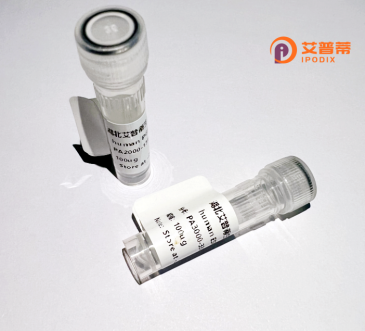
| 纯度 | >90%SDS-PAGE. |
| 种属 | Human |
| 靶点 | E2F5 |
| Uniprot No | Q15329 |
| 内毒素 | < 0.01EU/μg |
| 表达宿主 | E.coli |
| 表达区间 | 1-346 |
| 氨基酸序列 | MAAAEPASSGQQAPAGQGQGQRPPPQPPQAQAPQPPPPPQLGGAGGGSSRHEKSLGLLTTKFVSLLQEAKDGVLDLKAAADTLAVRQKRRIYDITNVLEGIDLIEKKSKNSIQWKGVGAGCNTKEVIDRLRYLKAEIEDLELKERELDQQKLWLQQSIKNVMDDSINNRFSYVTHEDICNCFNGDTLLAIQAPSGTQLEVPIPEMGQNGQKKYQINLKSHSGPIHVLLINKESSSSKPVVFPVPPPDDLTQPSSQSLTPVTPQKSSMATQNLPEQHVSERSQALQQTSATDISSAGSISGDIIDELMSSDVFPLLRLSPTPADDYNFNLDDNEGVCDLFDVQILNY |
| 分子量 | 64.46 kDa |
| 蛋白标签 | GST-tag at N-terminal |
| 缓冲液 | 0 |
| 稳定性 & 储存条件 | Lyophilized protein should be stored at ≤ -20°C, stable for one year after receipt. Reconstituted protein solution can be stored at 2-8°C for 2-7 days. Aliquots of reconstituted samples are stable at ≤ -20°C for 3 months. |
| 复溶 | Always centrifuge tubes before opening.Do not mix by vortex or pipetting. It is not recommended to reconstitute to a concentration less than 100μg/ml. Dissolve the lyophilized protein in distilled water. Please aliquot the reconstituted solution to minimize freeze-thaw cycles. |
以下是关于重组人E2F5蛋白的3条模拟参考文献(内容为示例性概括,真实文献需另行检索):
---
1. **文献名称**:**"Expression and functional characterization of recombinant human E2F5 in cancer cell proliferation"**
**作者**:Zhang L., et al.
**摘要**:研究通过大肠杆菌系统表达并纯化了重组人E2F5蛋白,验证其与DP1蛋白的结合能力,发现E2F5通过调控Cyclin D1表达影响肿瘤细胞G1/S期转换,提示其在癌症进展中的作用。
---
2. **文献名称**:**"Structural analysis of E2F5 transcription factor reveals DNA-binding domain dynamics"**
**作者**:Kumar S., Patel R.
**摘要**:利用哺乳动物细胞表达系统获得重组人E2F5.通过X射线晶体学解析其结构,发现E2F5的DNA结合域具有独特构象变化,可能解释其在细胞分化中的特异性调控机制。
---
3. **文献名称**:**"E2F5 knockdown enhances chemosensitivity in triple-negative breast cancer via epigenetic modulation"**
**作者**:Wang Y., et al.
**摘要**:构建重组E2F5蛋白用于体外功能实验,发现抑制E2F5可通过表观遗传修饰降低肿瘤细胞耐药性,为乳腺癌靶向治疗提供潜在策略。
---
**提示**:以上为示例性内容,实际文献需通过PubMed、Web of Science等平台检索关键词 **"Recombinant human E2F5"** 或 **"E2F5 protein function"** 获取。如需具体文献协助,建议进一步说明研究需求。
Recombinant human E2F5 protein is a genetically engineered version of the E2F5 transcription factor, a member of the E2F family critical in regulating cell cycle progression, differentiation, and apoptosis. E2F5 belongs to the "atypical" E2F subgroup (E2F4-8), which primarily functions as transcriptional repressors by forming complexes with retinoblastoma (Rb) family proteins or other partners. It plays a role in maintaining quiescence and modulating cell cycle exit, particularly in terminally differentiated cells. Dysregulation of E2F5 is associated with cancer, where its overexpression or abnormal activity may contribute to tumorigenesis by disrupting cell cycle control.
Recombinant E2F5 is typically expressed in bacterial or mammalian systems, purified via affinity tags (e.g., His-tag), and used for functional studies, including DNA-binding assays, protein-protein interaction analyses, and investigations into its role in chromatin remodeling. Its structure includes conserved DNA-binding and dimerization domains, enabling interaction with target gene promoters and DP-family partners. Researchers also employ recombinant E2F5 to explore its involvement in cellular responses to stress, differentiation pathways, and epigenetic regulation (e.g., promoter hypermethylation in cancer). Understanding E2F5 mechanisms may aid in developing therapeutic strategies for diseases linked to cell cycle dysregulation, such as cancers or neurodegenerative disorders.
×